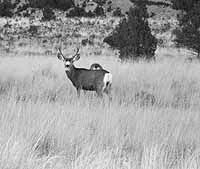| Utah’s general buck deer archery hunt is scheduled to begin Aug. 17. With hunters taking to the hills, wildlife officials remind outdoorsmen to use extreme caution while participating in hunting activities. |
By following a few, simple rules, Utah’s archery hunters can enjoy a safe experience in the state’s backcountry this season.
The state’s general archery buck deer hunt begins Aug. 17, while the state’s general archery elk hunt kicks off Aug. 22.
“There’s only been one recorded death of an archery hunter in the state’s history, so it’s a very safe hunt that way, but every year we have instances where hunters injure themselves,” says Lenny Rees, hunter education coordinator for the Division of Wildlife Resources.
Rees says most of the accidents happen because hunters are unsafe in tree stands, or they have arrows out of their quiver when they shouldn’t. In order to prevent such accidents from happening, the DWR provides the following advice.
•Tree stands. Before climbing a tree, make sure it’s large enough to hold one’s own weight. To avoid falling while climbing the tree, attach a hauling line to the bow, arrows and other equipment and leave them on the ground. After climbing into the tree stand, attach the safety line. Then use the hauling line to lift the gear up to the stand.
Rees also recommends using a portable tree stand, rather than constructing a permanent one. “Permanent tree stands have a tendency to deteriorate and, over time, become unsafe,” he explains. “They are unsightly, too, and a person damages the tree by putting nails in it.”
“Keep arrows in a hooded quiver that covers the broadheads, until they are ready to be used,” Rees cautions. “Archers jabbing themselves or hunters walking close to them, while carrying arrows in their hand that should be in their quiver, is one of the most common accidents during the archery hunts.”
State law requires that arrows be cased while in or on a vehicle. While outside the vehicle, it’s up to hunters to protect themselves.
Rees also provides archery hunters tips on getting prepared for the season, safety items to remember while in the field and tips on tracking animals and preserving meat.
•Preparation and equipment checks. Make sure laminations are not flaking or separating, that strings are not fraying and that the pulleys and cables on compound bows are in good working order. Also, be sure the equipment is matched, that the arrow’s spline (the stiffness of the arrow’s shaft) matches the bow’s draw weight. If a bow’s draw weight produces more force than the arrow is designed to handle, the arrow will probably fly off target.
•Broadhead sharpening. Be careful when sharpening broadheads. The broadheads should be sharp, but be extremely careful when sharpening to ensure that no cuts are sustained.
•Practice shooting as much as possible.
•Obtain written permission from private landowners before hunting on their property, or using their property to access public land.
•Obtain a general statewide archery buck deer permit and/or a general archery elk permit, and know the boundaries of limited entry units and other restricted areas in the area that will be hunted.
•Never take a shot at a deer or elk that is beyond the maximum, effective range. Also, before releasing the arrow, be sure of the target and what’s beyond it.
•After the shot. Watch the animal and determine the direction it took. Then go to the spot where the animal was last seen and find the arrow. If there’s blood on the arrow, and a compass is available, take a reading of the direction the animal went. Then wait 30 minutes before tracking it. Hunters who track an animal too soon can spook it into running. Most deer and elk that are shot will be found dead by the hunter at a reasonable distance, if the hunter waits 30 minutes before tracking it.
•When tracking an animal, look for blood not only on the ground, but the brush too. If the trail becomes lost, tie a piece of biodegradable paper on the last spot that is found and then search for the trail, walking a circular pattern out from the paper. The paper will serve as a marker, determining where the tracking began.
Also, tying paper at the locations of the last three or four spots that are found will allow the hunter to trace the direction the animal was headed in.
Once the animal has been located, make sure it’s dead by seeing if its eyes are open. If they’re not, the animal probably isn’t dead. If they are, touch one of the eyes with a long stick that will keep the animal a distance away.
Once the animal is dead, field dress and cool the meat immediately. The warm weather that usually accompanies the archery hunt can cause meat to spoil quickly.
Rees also advises archery hunters on ways to reduce conflicts with homeowners and people who don’t hunt. Some of his advice includes the following.
•Study and confirm access points to hunting areas well in advance. If access requires crossing private land, ensure written permission is obtained. If written permission cannot be secured, find another access point.
•Make sure that before hunting begins, the minimum distance from roads and dwellings is met. These restrictions are outlined in the current hunting proclamation and should be read closely.
•Avoid hunting in high profile areas. When possible, heavily used trails should also be avoided. “Most people in Utah choose not to hunt, but they support hunting and hunting-related activities as long as hunters are safe, legal and ethical in their conduct while in the field,” Rees explains. “When that does not happen, public favor can take a turn for the worse.”

